Articles
Kate Krueger: Growing a sustainable future through cellular agriculture
Kate Krueger: Growing a sustainable future through cellular agriculture
Cellular agriculture is the use of cell cultures to create new foods. This field of inquiry provides a unique opportunity for scientists from many backgrounds to contribute their skills to a common cause: reducing the impact of climate change and lowering the number of animals involved in the food system. Kate Krueger, the research director at New Harvest, describes modern cellular agriculture, its benefits, and how we can best promote its progress through research.
We’ve lightly edited a transcript of Kate’s talk for clarity. You can also watch it on YouTube and discuss it on the EA Forum.
The Talk
Thanks so much for the kind introduction. It's wonderful to talk with you all today.
I've been the research director at New Harvest for about two years now. New Harvest is a nonprofit research institute that funds food innovation technologies in the cellular agriculture space.
I’ll get into what I mean by cellular agriculture. But first I'm going to talk about something amazing and unique that we interact with every day: animal proteins in food.

Whether we're just looking at them or enjoying them in one form or another, I think we can all agree that food proteins are really amazing. Milk, eggs, fish, and meat all have unique biochemical properties that set them apart and make them an interesting combination of bioavailable nutrients that we know and love.
One of the things that we think about a lot at New Harvest is what goes into these complex products and how we could enjoy them in ways that don't involve animals. Because as amazing as these products are, they do affect the environment. Here's an image of an algal bloom taken from an aerial overhead photo at a feedlot.
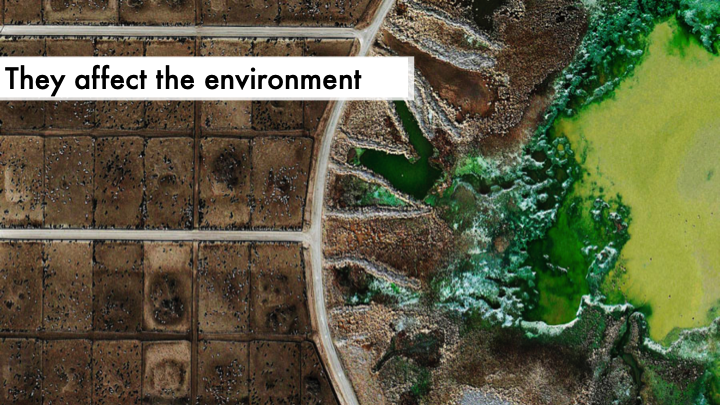
As you can see, these animals that we cultivate en masse have some really negative effects on the environment. In some ways, we are literally shaping the surface of our planet in adverse ways when we do factory farming.
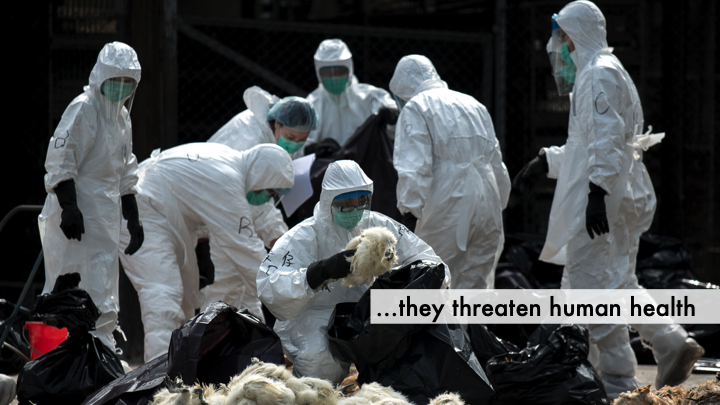
Beyond that, we also threaten human health. These products can be really unsafe. This is an image of a recent avian flu contamination in birds. In recent years, these infections frequently have jumped from birds to humans and other species. So it is not only unpleasant to think about these animals being packed in small areas together and confined, but really dangerous to human health.
At New Harvest, we like to think about other ways of creating food products that are animal-derived, but that do not involve the suffering of animals.

What if, instead of sacrificing a whole chicken to get its flesh, we could take a small tissue biopsy from that chicken and derive the same chicken breast?

Or what if, instead of cultivating a whole cow for its milk proteins, we could simply take a culture of cells and train it — through genetic modifications and other biotechnologies — to produce that same milk protein to make the beverage we know and love?
Since the advent of this field, which we call cellular agriculture — the production of both cellular and acellular products to make food from cultures rather than from whole animals — there have been a number of small, one-off [innovations].

Perfect Day Foods has produced some milk protein in recent times and even ice cream. There have been a few prototypes of eggs without hens from Clara Foods, and Mark Post created his iconic burger (an early example of beef without cattle).

Also, a number of companies have cropped up in both the protein space and the cultured meat space. This is just a smattering of the 20-plus companies in the market. There's no longer room for them all on one slide, which just shows how vast and varied the companies in this space are. They are from around the world, with a concentration of them in San Francisco. So it's very exciting to see the whole ecosystem begin to develop.

Here at New Harvest, we think a lot about not only how to use these products to make a better food product, but how to make cellular agriculture an actual field. How can we help it develop faster and stronger?

How do we turn a few ideas, prototypes, and startups into a full-fledged academic discipline and a business sector?
So how might we piece together the different disciplines that go into the field of cellular agriculture to create something wholly new that involves the synergies of these different fields?

Here are a few of the main fields that make up cellular culture: chemical engineering, bioengineering, and cell biology. There are a number of others — mechanical engineering, STEM cell technologies, biochemistry — that, together, create the unique network that forms cellular agriculture.
At New Harvest we think of this as a job that requires us to involve many different parties.

[For example], to effect change, do we need to involve not only principal investigators or professors who run their own labs, but also researchers — the graduate students and postdocs doing the science in the labs?

If our goal is to go from Mark Post's single burger to many, we hope to create an ongoing supply of many burgers at a reasonable price. There's a lot we need to do. And that's because, while a lot of the bioengineering to make this process happen has been mostly pioneered at a lab scale, most of those early demos are about the size of the head of an eraser.
Food is not only an amazingly complex thing, it's an amazingly inexpensive thing. So not only do we have to accomplish a whole lot of great science, we have to do so in a way that's extremely cost-effective. That leads to our major research questions of the field.

Part of what makes what we do distinct from the field of tissue engineering, or human tissue applications, is the question: How do we make cost-effective cell-growth media? If we're growing and forming cells into either an unstructured burger or, down the road, a structured steak, we need to be able to grow cost-effective food for those cells. Current media formulations are available, but they tend to be really high-cost and medical-grade in nature. That's something that needs to change for this field to grow in a healthy way.
A lot of companies are doing this wonderful, important work in-house. It's a bit challenging, though, because each company has its own formulations, so everyone's inventing their own wheel, [so to speak]. So at New Harvest, one of the things we're interested in is helping us use common prototypes and “wheels” for people to share, instead of everyone needing to create their own basic tools.
Also, how do we tweak cells to better grow at scale through modern biomedical innovations? In this day and age, we're really good at genetic modifications and non-genetic modifications in different biotechnologies. So what tweaks are necessary — and what tweaks can we standardize and put out there into the world as useful things that can help people grow cells at scale?
Also, how can we make a bioreactor for 3D muscle growth? This is something that really has never been done at scale for cellular agriculture. It's a new innovation that poses a number of challenges, both from a chemical-engineering perspective of kinetics, and also from a mechanical-engineering perspective — not to mention the basic biology and bioengineering components that go into this project.

To that end, our areas of research include bioreactor design, tissue engineering, bioengineering, and developmental and STEM cell biology. And while these are all important areas that we need to focus on, none of them really map to cellular agriculture. Most have been developed with biomedical or basic research applications in mind, so to apply them to case studies with food requires a bit of effort.

That brings us to our next challenge, which is funding. How do we get money to do this work? You may be familiar with the standard valley-of-death metaphor for the development of modern pharmaceuticals. If you're not, here's a rundown. Basically, the way most drugs, at least in the United States, get funded today is through public funding from the National Institute of Health (NIH) and the National Science Foundation (NSF). It’s mostly through the NIH. Professors at universities can apply for and win competitive grants, and then develop novel innovations. When one of those innovations looks promising enough, it can lead to the development of a drug. And then that drug development often gets picked up by a company. But during that initial proof-of-concept work to develop enough rationale for a company to pick up a drug, many companies die. That creates this funding gap, or what is called “the valley of death.” This is a really hard problem that people struggle with in getting a product from the research and development phase, or university phase, to actual drugs you can find on the shelves.

In cellular agriculture, though, the funding gap is much more extreme. And this is where those of us who have an affinity for effective giving come in, because there really is no upstream funding source short of organizations such as New Harvest. The public funding stream does not, at least in the United States, come from the government. In certain countries there are exceptions. Japan recently gave some money toward cellular agriculture. The Netherlands has funded it in the past. But most countries have not, and the U.S. certainly has not. And so we address this public funding [gap for] pre-competitive stage research, which can hopefully help aid innovation in the entire sector.

To that end, we aim to fund work that leads to major technical innovations. And when I say major technical innovations, I don't mean incremental progress that’s necessarily what a VC [venture capitalist], for example, is looking for. I mean something that's really going to change the field and help us develop into a more robust sector as a whole.
We also aim to train the talent pipeline for the entire sector. So on top of getting technical innovations that the entire field can use, we are training the scientific talent that can enter this space.

We see ourselves as an academic hub. We connect a number of different universities, a few in the U.K. (I’ve got to give a big shout out to the University of Bath, where we work with Dr. Marianne Ellis and Scott Allan, and the University of Newcastle as well, where we work with Dr. Che Connon and Dr. Ricardo Gouveia), and then a number of other universities in the U.S., U.K., Canada, and now in New Zealand. There isn't a hub for New Zealand yet because it's new, but we're very happy it's part of the list.

So at New Harvest I think of myself as kind of the science officer. I'm essentially like the Dax on staff, but effectively I'm much more like a VC or a portfolio manager. And that's really because of the nature of the work we do. We support the entire sector of cellular agriculture from a basic research standpoint.

Instead of pursuing one or two research avenues, as you would need to do if you were at a company with finite resources and extremely short timelines, we pursue a broad portfolio of projects. Those projects focus on genetic modifications, cell media modifications, bioreactor design, hardware, fat development, and different scaffold materials that can grow cells.

As I see it, this kind of forms the two wheels of a bike to propel us into the future. And the reason I think that's so cool is that just about all of the companies on that first wheel of the bike have direct ties to New Harvest through our training pipeline. New Harvest spun out Perfect Day Foods and Clara Foods back in 2014. Meatable was started by a New Harvest intern, and another, Memphis Meats, is where one of our early fellows, Marie Gibbons, currently works. Finless Foods was also started by a New Harvest intern, and New Age Meats is where our [board of directors’] treasurer [John Pattison] currently works. So it's a small web where we all fit together. And of course you can't go anywhere without a basic research pipeline, so we're very proud of that.

So whereas companies are focusing on what I’d call “cellular agriculture 1.0 or 2.0,” which is what's necessary for a short-term, VC-type funding pipeline, we're focused on 3.0. So why is that a salient difference?

I'd argue there are a lot of reasons. When you're focusing on 3.0, which is more like a five- or 10-year time horizon, you can think about things like nutraceuticals — how to make foods that are healthier than they've ever been before — and food in space. You're not going to take a cow up if you're headed for the deep space gateway. That's really important.
We also focus on structured products — things like steak or sashimi — which some companies are starting to work on, but that's a little bit further on their time horizon, and things like new bioreactors or better cell growth media for everyone. [These projects are in contrast to] the obvious and very wonderful benefits that we get from companies working on things like unstructured products, meat analogs, simpler design, and hybrids.

So what does that mean for outcomes? From a production standpoint, we're hoping that we get a talent pipeline out of this: PhDs, CTOs, publications. I’d say that a goal of research is always moonshots. We don't expect everything to be a moonshot, but when you're engaged in pre-competitive, early-stage research, it's always on the table. You can always discover something new and innovative that you did not expect.
Also, I would argue that incremental progress is a given with basic research. And that's in addition to the benefits, of course, of company product developments, creating enthusiasm in the space, recruiting talent, and [directing] investment, which are all notable and wonderful things that work together to create a healthy field.
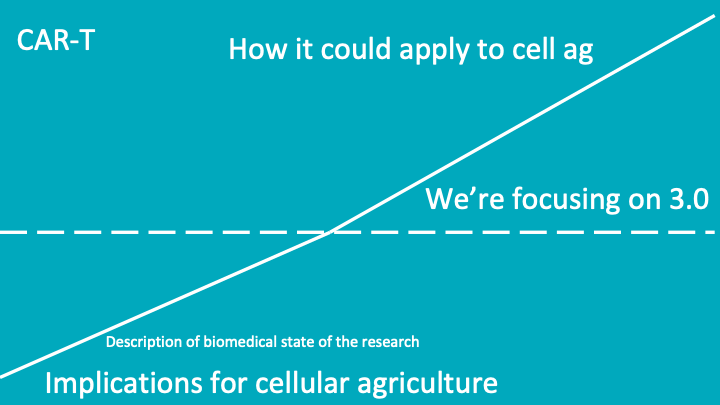
Focusing on 3.0 allows us to take scientific innovations like CAR T, which is a therapy in which cells are removed from a patient's body and reprogrammed to fight cancer, and think about how that could apply to cellular agriculture. So that's a little bit out there, and it might not be something to consider on a six-month or year-long time horizon, but if you're thinking in terms of five or 10 years, you can certainly think about CAR T.
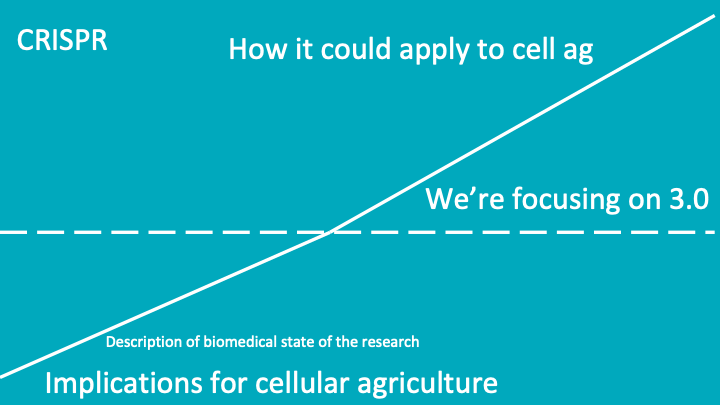
And some companies are working on CRISPR. We're also very interested in genetic modifications for cellular agriculture — again, with a longer time horizon that allows us to further capitalize on these new technologies.

We also consider cool new products — things that others can't [contemplate] because of [short] time horizons or because of what's popular at the moment. These products could include open-source bioreactors or mushroom-meat hybrids. It's all on the table when you've got a longer time horizon.

So our aim is to be catalytic by reducing what I’d call the Gibbs free energy of activation for cellular agriculture. How can we prime this system to be as effective as possible?
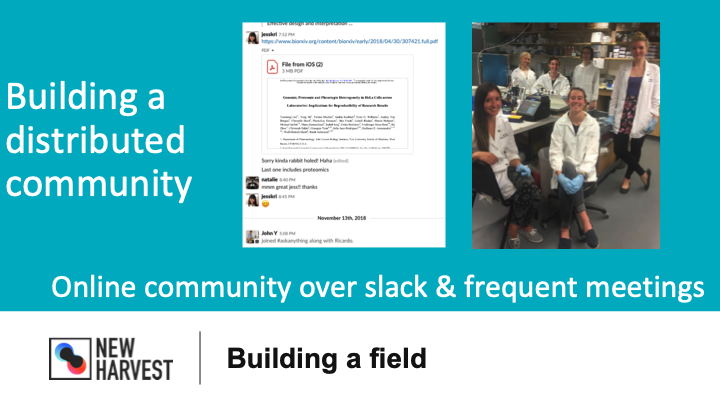
To do this, we’ve really tried to create an environment that's conducive to the development of a new field, and that often takes forms that one would not expect. It involves things like making sure everyone's in the same place once every six months at our gatherings (we call these gatherings “lab meets”), and building a distributed community over Slack. Sometimes the things that bring us all together are not very expensive at all. At New Harvest, we really try to promote the importance of community, and sharing resources and protocols, to help develop science together.

This is just a scramble of some of the words we get in our proposal calls every year. It's always exciting to see what people bring in. Everyone's trying to make things. Serum-free culture is a big goal for us right now. Incorporating plants is really important for us. All of this is what comes together to build a field.
Another key part of what we do is try to communicate with our donor base. Our donors are wonderful people who are actively engaged, in many cases overseeing and interacting with the research in a variety of ways. Most of them are regular readers of our newsletters, where you can kind of get a lab-side view of what's going on in the research.

You can look over a scientist’s shoulder, in essence, and see a little bit of what's going on with their microscopy that day, as you can see in some of these images here, such as that great red image of muscle cells or of a hollow fiber bioreactor.
Through sharing these stories and the technology of what we do, we hope to bring everyone in and make this an even bigger community than the one we started with. We partner with a number of different organizations to make this possible.

The two or three most recent are Avina Stiftung, which is one of our new funders, and universities like UCLA and the University of Auckland. And we're really proud to have all of these folks in our community. They support the work we do and make for a stronger research operation.

In conclusion, I'd like to argue that funding research in cellular agriculture requires innovation, that a productive research foundation must be created and doesn't necessarily just come into being without a fair amount of effort and thought, and also that communicating research can bring us all a little bit closer in what we do.

Our next steps at New Harvest are to expand our efforts in open hardware and ocean science, bring in new skills from fields like cancer biology and the physics of food, and expand new programs such as our seed grant program for undergrads and our dissertation award for people finishing up their PhDs.

I'd love to acknowledge our fellows, PIs, staff, donors, and mentors, in addition to EA Global for having me here today. This has been a wonderful opportunity to share a little bit of what we do at New Harvest and why we do it.
If you're interested in any of these types of interactions in cellular agriculture, whether it's funding, working in cellular agriculture, or doing research, [reach out]. I'd love to chat with you about what this work could mean for you. We're stronger when we work together. Thank you so much.
Moderator: [Audience member] Martin says, “I'm a computer science student specializing in theoretical CS, but also take great interest in cellular agriculture. Do you think there are technical tools that would benefit cellular agriculture researchers, for example, better programming libraries, simulation tools, or even computing hardware?”
Kate: That's a great question. In terms of cellular agriculture and how it could interplay really nicely with computer science, the clearest connection that I see right now is with things like protein simulations for software that can help us understand how protein folds or how to optimize a protein design.
Oftentimes, what we're really good at doing in the lab is sticking a chunk of DNA from one organism into another species. The trick, though, is figuring out which chunks of DNA to put in to get the protein that's as strong or stable as we want. And that's a problem that is really well-suited to a lot of people who have backgrounds in CS, physics, or something in that area.
If you're interested in learning more about that, check out the work of Dr. David Baker at the University of Washington, Seattle; I'm also happy to chat more about how those kinds of applications could look. There are also some people doing interesting stuff involving AI, I think, but I don't know many details. I definitely would suggest looking at protein folding and structure first.
Moderator: Awesome. That was really helpful, thanks.
There's a lot of uncertainty around consumer acceptance and the regulation of cellular agriculture projects. But one of the things that we've consistently heard is that the science is there. My boyfriend is a PhD student working on cellular agriculture at Tufts University, and what I've noticed is that he and his colleagues tend to be less optimistic about the science than what we hear in these presentations. So I want to get your take and find out what you think the biggest scientific hurdles are and, from your slightly more removed perspective, how close we are to overcoming those. What's the timeframe?
Kate: Yeah, that's a great question. This is one of my favorite questions in this space. So first, a big shout out to Tufts University and Dr. David Kaplan's lab. I'm a huge supporter of their work. New Harvest funds a lot of research there and we're really proud of what they are accomplishing.
On a technical note, what I'd say is the science is there if you want to create something very small and very expensive. The challenge with cellular agriculture is that, in my opinion, it's not enough for the science to be there; the technology also needs to be there to reduce costs. For that reason, I don't think we're there yet.
Certainly, the science is there to create a multi-thousand-dollar tissue implant that is a one-time thing that a person needs, or maybe a piece of meat the size of a pencil eraser that costs lots of money. But I think it’s going to take on the order of five years to get those costs down [to produce] something that's more fully cellular agriculture and that lacks structure.
That doesn't mean there isn't a lot of room for optimism. I'm really excited about things like blended products that are partially plant-based and partially animal-based. It's reasonable to think we could create those in a timescale of 18 months or two years. I’d say it's likely we'll have blended products in under five years. For more structured products, that's harder to do, so that's going to take a little longer.
So I think the science is sort of there. But obviously it's not there until we can buy these products on the shelf. Even so, research in food science is something that goes on all the time. So I'd argue that it's worth pursuing this work.
Moderator: Great. Thanks so much, Kate.
Kate: Thank you.